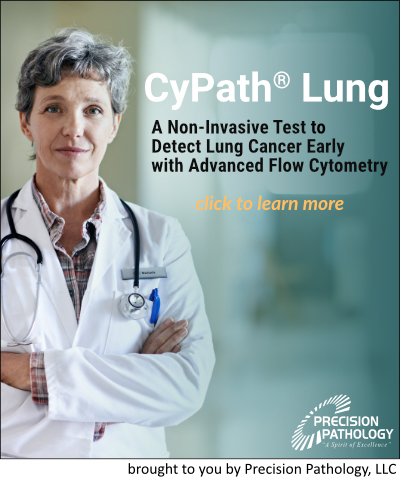Texas Public Radio
To listen to the story, click here.
AUGUST 24, 2017
By Wendy Rigby,
Bioscience and Medicine Reporter
A new, more accurate, test for lung cancer is being developed in San Antonio. It’s a screening that could help save the lives of thousands of people who are often diagnosed too late to survive the disease.
Checking for lung cancer may soon be as easy as coughing up a sample of flem, spitting it into a cup, and shipping it off to the lab.
A company called bioAffinity Technologies, Inc. saw a need for a new, non-invasive way to screen for a killer. By the time most lung cancer patients are diagnosed, they don’t fare well, says bioAffinity president and CEO, Maria Zannes.
“A five-year survival rate for prostate cancer, breast cancer, is in the high 90 percent. For lung cancer, it’s only 17 or 18 percent,” she explained.
Right now, at risk patients can undergo CT scans for screening. But there’s a high false positive rate. Only 4 of every 100 people flagged by a CT actually have lung cancer. That creates worry, cost, and pain associated with unnecessary biopsies.
So that’s where this experimental system would come in. Using a device called an acapella that assists in loosening up mucus in the lungs people spit into the collection cup for three days. They refrigerate the sputum sample and then ship it off.
Once at the lab, the cells are processed and tagged with a man-made compound. Only the cancerous cells shed from the lining of the lungs or the blood will glow a fluorescent red color.
Using a process called flow cytometry, the cells are sucked from a tube. The machine looks to see if any of them are cancerous. It’s fast. In just about a half hour, it can process 20 to 30 million cells.
“Then you can actually see that the cancer cells have taken up more than the surrounding cells,” said Executive Vice President of Research and Development Vivienne Rebel, MD. “Those cells that take it up very highly are either cancer cells or cells that are very associated with it.”
A person with a positive test could then be referred for a biopsy with more certainty they actually need it, hopefully catching the cancer sooner, and perhaps saving their lives.
A promising sidebar? The fact that this tagging system can detect cancer could lead to new drug delivery systems. A medication could be attached to the marker that gets taken up only by cancer cells. Leveraging the process to work for targeted therapy for many cancer types is a provocative concept, says senior vice president for therapeutics Bill Bauta, MD.
“So this is not something that is based on a specific biomarker for a specific kind of cancer,” Bauta emphasized. “I think we’re dealing with something much more general. That excites and motivates me in this area.”
The test – called CyPath Lung — is still in the testing stages. Early results from small studies show an accuracy rate of more than 90 percent. A proof-0f-concept study was published in the Journal of Thoracic Oncology.
CyPath Lung could be commercialized in another couple of years, available by prescription and surprisingly affordable, according to president Maria Zannes.
“We’re looking at about a $300 test and it’s reimbursable,” she added.
Advances in the lung cancer field are desperately needed. More than 150-thousand Americans will die of lung cancer this year. It’s the number one cancer killer of men and women.
(Company Note: Early studies at Los Alamos National Laboratory and internal trials showed higher than 90% accuracy. The most recent clinical trial (Patriquin, et al., Journal of Thoracic Oncology, September 2015) used a microscope-slide-based system to measure one-third of a sample and resulted in 81% accuracy. That study calculated that the ability of the test to find cancer in a sample would rise to greater than 95% if a greater amount of the patient’s sample were measured. bioAffinity Technologies currently is conducting clinical trials to confirm the accuracy of our flow cytometry system that would analyze a person’s full sputum sample, or roughly three-times more of a patient’s sputum sample than the amount measured in the Patriquin study.)

